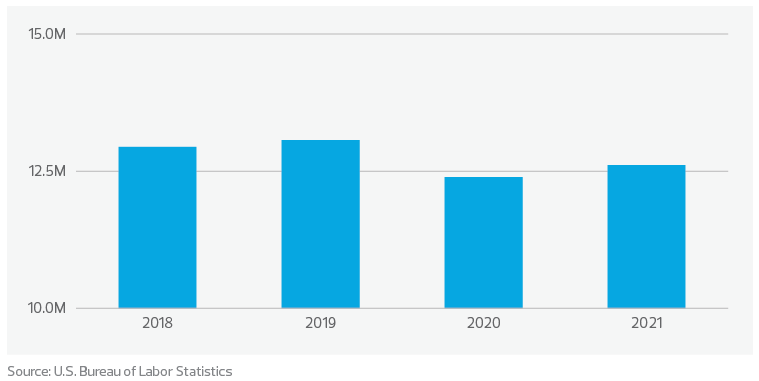The need for women in manufacturing presents a significant opportunity for companies.
Key takeaways
Manufacturers should assess how well they currently foster workplace flexibility.
A needs assessment can help determine how women can fill current talent gaps.
Workplace flexibility and clear career progression paths can boost recruitment
Long underrepresented in manufacturing, women are a tremendous potential resource to fill the talent gap in that industry. The manufacturing sector has been hit hard by the labor shortage, and there’s no sign of that changing.
Approximately 32,000 jobs were added to the U.S. manufacturing sector in October, according to the Bureau of Labor Statistics, as compared to 30,000 in the prior year comparative period. But of the 15.8 million manufacturing employees in the United States as of 2022, only about 30% are women, according to ThomasNet.
The industry has long suffered from the stigma that manufacturing is a man’s job. Manufacturing plants were for many years seen as unsafe environments, which may be one reason so few women work in the sector today. Another is that the historically long, inflexible hours have been incompatible with the more flexible schedules women supporting young families tend to seek. According to the 2022 Women in the Workforce study by McKinsey, 49% of women leaders say flexibility is one of the top three considerations in job mobility.
Closing the gender gap should be a key strategy for manufacturers looking to address the talent shortage and prepare their factories for the future. But successful recruitment and retention of women in manufacturing requires consideration of a number of factors, including:
Leveraging education and training
According to recent data from the National Student Clearinghouse, 59.5% of college students are women. Further, women make up over 60% of students pursuing advanced degrees according to data from the Council of Graduate Schools. In addition, over 60% of women under 30 want to advance in their careers and become senior leaders, according to the McKinsey study. Herein lies the opportunity for women to fill various gaps in the manufacturing workforce. A huge, untapped talent pool of college-educated women will fit the bill of the new-collar worker, equipped to lead teams and use the technology that increasingly drives efficiency and profitability in the manufacturing sector. communications.
U.S. manufacturing jobs

Four-year college degrees by gender

Workplace flexibility
Flexibility has been a huge area of focus during the pandemic, with workers demanding the ability to work remotely or to choose their hours. Flexibility is especially crucial for women in the workforce, given that childcare responsibilities in many families fall to women. Manufacturers that want to remain competitive in the future should assess whether they currently foster flexibility throughout their operations. If not, teams should determine and implement the changes needed, which could include location flexibility and offering benefits related to child care.
Compensation and paths for advancement
The gender wage gap persists for women in the U.S. workforce, and manufacturers that proactively address that inequity will have a competitive edge when it comes to attracting and retaining women on their teams. Alongside competitive compensation, companies should have thoughtful career progression frameworks that highlight opportunities for advancement. Developing a career advancement plan through the lens of the manufacturing evolution could help to draw more women into the field. Manufacturers might consider working with a third party to perform a needs assessment and help determine how women can fill current talent gaps.
ESG impact
One reason for companies to promote women into leadership roles is that businesses are being judged on how well they meet environmental, social and governance criteria, as we wrote in a recent article. RSM research found that gender diversity among board members is among the top 10 factors that determine a company’s ESG performance, and increasing the percentage of female board members from 0% to 50% can help improve a company’s ESG performance by 2.7%. In an evaluation process that factors in hundreds of variables, that increase is substantial.
The need for women in manufacturing is clear and presents a significant opportunity for manufacturers to fill their talent gaps. Leaders need to think through how to create an environment that meets women’s need for flexibility in work hours and location and provides opportunities for career progression. The ability to succinctly communicate and execute on a viable and desirable career plan—one that focuses on career growth, flexibility and unique development opportunities rather than longevity in a given role—will go a long way in the effort to recruit and retain female talent.
TAX TREND: Manufacturing
As manufacturers sharpen their strategies for recruiting and retaining women, considering the tax implications of cash and noncash compensation will help them avoid surprising tax obligations, which should make their strategies more sustainable. From education assistance programs to equity compensation to retirement plans, there are tax implications to the many ways in which employers compensate their workers.
RSM contributors
Related manufacturing industry outlooks
Building a sustainable future:
Aligning ESG strategy with business priorities
RSM's 2024 guide details the multifaceted ecosystem of ESG and sustainability. It provides an in-depth analysis to foster responsible business practices consisting of strategies, technologies, processes and data.


